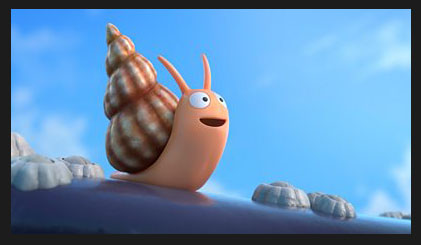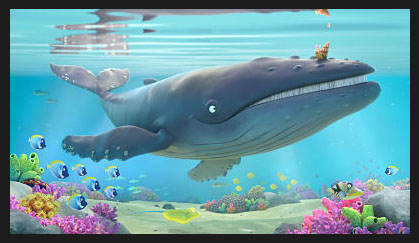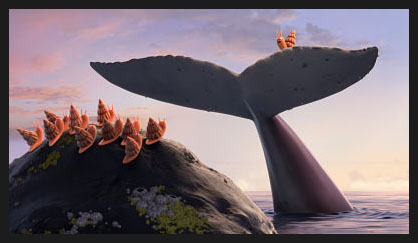
Max Lang and Daniel Snaddon have made some of the most beloved animated short films and specials of the last 15 years, including The Gruffalo, Revolting Rhymes, Stick Man, Room on the Broom, Zog and Albert. Now they’re co-directors of a new short that’s vying for Oscar and Annie Awards consideration, The Snail and the Whale.
Jackson Murphy: Do you realize the kind of impact you’ve had on the animation world over the past 10-15 years?
Max Lang: Oh. (laughs) That is a good question. To be honest, I don’t think too much about that. I really just love making films, and if there’s a great story to tell, then I try to do that.

Daniel Snaddon: I know Max has had a huge impact on my career.
JM: Like several of the other projects you’ve been involved in, The Snail and the Whale is based on a Julia Donaldson book. What has your relationship with her been like over the course of these shorts?
DS: Julia has always been very encouraging but not too… micromanage-y. She’s been fantastic. And I think that has a lot to do with how well Max and Jakob [Schuh] set-up this relationship with The Gruffalo. They built a lot of trust there very early on – very respectful to the original source material. We reap the benefit of that too.

Max Lang
ML: We watched a lot of documentaries. But I’ve been thinking about making this film for over 10 years, so I’ve been lucky enough to go on a whale watching trip in Alaska a few years back. That definitely inspired some of the shots in the North American section. I dug out my old pictures. I would say countless references and thoughts have gone into that.
JM: Wow. This has been in your mind for 10 years, and you’ve had several animated shorts and specials come out in that period of time. Why did it feel like now was the right time for The Snail and the Whale?
ML: It really was not possible before for several reasons. It was really, really challenging to adapt because the main characters are a tiny, tiny snail and a giant whale. They hardly fit into the same frame. They don’t have hands. They’re not very anthropomorphic. They can’t interact with each other. Adding to that, we don’t want to really add too much new dialogue that isn’t in the book. So we’ve been figuring out the best way to adapt this story for a long time. At the same time, it’s always been one of my favorite picture books. I’ve read it to my kids several times. I’ve read it for myself countless times. It was always in the back of my head and I was always trying to get Magic Light Pictures to… “Yeah. Maybe we can do it. Maybe we can figure it out.”
But there are always technical challenges, of course, because on the other films, comparatively… you look at them and there are a few shots of special effects in each film and they take us the whole period of production to work on. In this film, almost every shot is a special effects shot. So that was very daunting. And then [about] three years ago when we started working on this, it was really the perfect time. It was kind of the only possible time I could think of doing this film. It’s really crazy. I don’t even think you could do it now. (laughs) It was this perfect moment where it all came together.

JM: A one-time only experience. You got it done. And you’re right about the minimal dialogue. Sally Hawkins voices the Snail. I watched an interview with the director of a film she was in recently (Eternal Beauty). And he talked about how she was so method as far as getting into character and her performance. Could you tell that even in her voicing a snail?
DS: Oh yeah. Absolutely. We’ve worked with Sally before on Stick Man and Room on the Broom. She’s a genius. As soon as she comes into the room and we turn on the microphones, there’s so much wonderful thought and experience and variety that comes out. And I noted afterwards that… I hadn’t realized at the time… but she came prepared with a voice for a snail. And it was only in going back to interviews with her and hearing her talk that I realized, “Oh that’s not how Sally sounds. That’s her snail voice that she’s doing.” But she made it seem so natural and effortless, we just never questioned it. It’s so amazing.

Daniel Snaddon
ML: For the narrator we wanted a voice that is very grounded and yet doesn’t compete with the whale’s voice [Rob Brydon]. We had been looking at a lot of candidates. She just stood out because at the same time she was emotional and there was this…
DS: Warm and authoritative. Not an easy combination to find.
ML: She just brought all this to it. And we haven’t seen a female narrator that often in a role like that, which has such a gravitas. She brought all that to the table. It was a very, very humbling experience to work with her. She had it all worked out and was really perfect. It’s always intimidating if you work with people like her.
JM: Fans of hers will love hearing her narration, especially as we get to the final section, which is one of the most successful emotional aspects of any of your shorts. It’s choreographed so well and handled so well. Did you feel the weight of it as you were making it like we feel as we’re watching it?
ML: Since we’ve been thinking about it for such a long time, there was always a lot of pressure on this project. I would say it’s our best and we always wanted it to be our best film. At the same time it was the most challenging of all the films. When we looked at it on paper with all the experience that we have of making these shorts, it was impossible to pull off. The assets count, the different scales, the water effects and still wanting to hit all the right beats in the story. It was a very, very daunting task. And there was a very brief period where we were all sitting together and doubting if we could actually make it. It took a lot of optimism and just shooting for the stars to make it. Luckily, we had such an amazing team. They always put in the extra work and put in amazing results.
JM: A lot of your shorts and specials are released in other places around the world before they come to America. Have you noticed that different audiences in different parts of the world respond to different portions or aspects of your films?
DS: My experience of watching the movies with audiences is very limited. I’ve had friends who have sent me pictures because… it gets theatrically released in certain territories, like France and Spain. If there’s a poster up and they see it, they’ll send me a picture. And that’s always a thrill. In England, it’s amazing to be there when these films are being released because Julia Donaldson is such a celebrity there. Her books are very beloved and there’s a lot of exposure for the films. It feels like an event, which is really exciting. It’s a real privilege. And here in South Africa, you can catch them on streaming.

JM: Speaking of “event”, every year for the past 12 years or so I’ve gone to one of my local multiplexes to see the Oscar Nominated Animated Short Films presentation. Max, you’ve been nominated twice for an Academy Award and many of them have played in this presentation. What have the nominations and having your films play in this presentation meant to you?
ML: Again, a very humbling experience. When you see in the theaters and watch these shorts together with the other nominees… each of the shorts is so well crafted and so well done. And they’re all so different. It’s kind of comparing apples and oranges. All of them are great and I want all of them to win. And it’s so well organized by The Academy that you get to meet the other filmmakers and you become friends and that leads to projects, collaborations and relationships down the road. It’s mostly for me both a community and that you experience everyone for who they are and what they’re doing. You appreciate everyone’s work. It’s kind of nice that it becomes less about the awards themselves and it’s just about making films and telling good stories – and interacting with your peers.
JM: The night after I watched Snail, in casual conversation I happened to be rhyming a couple times. I couldn’t believe it. Is rhyming so embedded into your brains?
ML: The Snail and the Whale is one of Julia Donaldson’s best poems. It’s so well rounded. The characters come to life in the rhyme and there’s such a beautiful rhythm in it. I really, really love reading the book. It’s a pleasure to read to your kids and your nephews.
DS: I have a two year old, and it’s amazing that because of the rhymes, he can start to recite words that he has no idea what they mean. He doesn’t know the context of what he’s saying but he understands the words. So yeah, it really gets into the back of your skull. It’s amazing.
- INTERVIEW: Strap In For “Mars Express” - April 30, 2024
- INTERVIEW: Jeff Fowler On “Knuckles” And “Sonic 3” - April 22, 2024
- INTERVIEW: “Inside Out 2” Director And Producer On Pixar Sequel - April 16, 2024


 January 5th, 2021
January 5th, 2021  Jackson Murphy
Jackson Murphy  Posted in
Posted in  Tags:
Tags: 






